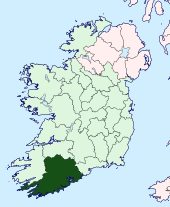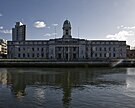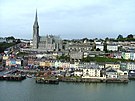County Cork: Difference between revisions
| Line 31: | Line 31: | ||
===Rivers and lakes=== | ===Rivers and lakes=== | ||
The three great rivers—the [[River Bandon|Bandon]], the [[River Lee|Lee]] and the [[ | The three great rivers—the [[River Bandon|Bandon]], the [[River Lee|Lee]] and the [[Munster Blackwater|Blackwater]] and their valleys dominate central Cork. Habitats of the valleys and floodplains include woodlands, marshes, fens and species-rich limestone grasslands. The river Bandon flows through many towns including Dunmanway in the west to the town of Bandon before draining into Kinsale Harbour on Ireland's south coast. Cork has two well-known sea loughs, Lough Hyne and Lough Mahon, and also contains many small lakes. An area has formed where the River Lee breaks into a network of channels weaving through a series of wooded islands. There are 210 acres of swamp around Cork's wooded area. The Environmental Protection Agency (EPA) carried out a survey of surface waters in County Cork between 1995 and 1997 which identified 125 rivers and 32 lakes covered by the regulations. | ||
===Coastline=== | ===Coastline=== | ||
Latest revision as of 11:44, 6 October 2016
| County Cork Irish: Contae Chorcaí Republic of Ireland | |

| |
|---|---|
| [Interactive map] | |
| Province: | Munster |
| Area: | 2,895 square miles |
| Population: | 518,128 |
| County seat: | Cork |
The County of Cork is a shire on Ireland's southern coast. Located in the province of Munster, it is named after the city of Cork. In 2011, the county's population was 518,128 making it the second most populous of the counties in the state.[1] In common with County Tipperary it is split into two "Ridings", analogous to those of Yorkshire.
Geography
Cork borders four other counties: Kerry to the west, Limerick to the north, Tipperary to the north-east and Waterford to the east. Cork is the largest county in the state by land area. The population of Cork city stood at 119,230 in 2011. The population of County Cork is 519,032 making it the state's second-most populous county, although the peak population in 1841 was recorded as 854,118.
Baronies
There are 22 baronies in the county:
The East Riding consists of the baronies of Duhallow, Orrery and Kilmore, Condons and Clongibbons, Fermoy, Kinnatalloon, Imokilly, Kerrycurrihy, Kinnalea, Barrymore, Barretts, and East Muskerry (with the exception of the parishes of Ahinagh and Aghabologue), together with the Barony of Cork and the Liberties of Cork and Kinsale.
The West Riding is composed of the baronies of Ibane and Barryroe, Bear, Bantry, West Muskerry, Kinalmeaky, Courceys, East Carbery (east and west divisions), and West Carbery (east and west divisions), with the two parishes of Ahinagh and Aghabologue, in the barony of East Muskerry.
Civil parishes and townlands
There are 253 civil parishes in the county.[2]
There are approximately 5,447 townlands in the county.
Mountains and upland habitats
The county's main mountain ranges include: the Slieve Miskish and Caha Mountains on the Beara Peninsula, the Ballyhoura Mountains on the border with Limerick and the Shehy Mountains which contain Knockboy (2,316 ft) the highest point in Cork. The Shehy Mountains are on the border with Kerry and may be accessed from the area known as Priests Leap, near the village of Coomhola. The Galtee Mountains are located across parts of Tipperary, Limerick and Cork and are Ireland's highest inland mountain range. The upland areas of the Ballyhoura, Boggeragh, Derrynasaggart and the Mullaghareirk Mountain ranges add to the range of habitats found in the county. Important habitats in the uplands include blanket bog, heath, glacial lakes and upland grasslands. Cork has the 13th highest county peak in Ireland.
Rivers and lakes
The three great rivers—the Bandon, the Lee and the Blackwater and their valleys dominate central Cork. Habitats of the valleys and floodplains include woodlands, marshes, fens and species-rich limestone grasslands. The river Bandon flows through many towns including Dunmanway in the west to the town of Bandon before draining into Kinsale Harbour on Ireland's south coast. Cork has two well-known sea loughs, Lough Hyne and Lough Mahon, and also contains many small lakes. An area has formed where the River Lee breaks into a network of channels weaving through a series of wooded islands. There are 210 acres of swamp around Cork's wooded area. The Environmental Protection Agency (EPA) carried out a survey of surface waters in County Cork between 1995 and 1997 which identified 125 rivers and 32 lakes covered by the regulations.
Coastline

Cork has a mountainous and flat landscape with many beaches and sea cliffs along its coast. The southwest of Ireland is known for its peninsulas and some in Cork include the Beara Peninsula, Sheep's Head, Mizen Head and Brow Head. Brow head is the most southerly point of mainland Ireland. There are many islands off the coast of the county in particular off West Cork. Carbery's Hundred Isles are the islands around Long Island Bay and Roaringwater Bay. Fastnet Rock lies in the Atlantic Ocean seven miles south of mainland Ireland making it the most southerly point of Ireland. Many notable islands lie off Cork including Bere Island, Great Island, Sherkin Island and Cape Clear Island. Cork has 684 miles of coastline, the second longest coastline of any county after Mayo which has 730 miles.
Land and forestry
Like many parts of Munster, Cork has rich fertile agricultural land and many bog and peatlands. Cork consists of approximately 182,860 acres of peatlands which amounts to 9.8% of the county's total land area. And the county contains approximately 195,680 acres of forest and woodland area or 10.5% of Cork's land area which is decently higher than the national average of 9%.
Wildlife
The Hooded Crow, corvus cornix is a common bird, particularly in areas nearer the coast. Due to this bird's ability to (rarely) prey upon small lambs, the gun clubs of Cork County have killed a large number of these birds in modern times.[3]
A collection of the marine algae is housed in the Herbarium of the botany department of the University College Cork.[4]
Parts of the south-west coastline are a hotspots for sightings of rare birds, with Cape Clear being a prime location for bird watching. The island is also home to one of only a few Gannet colonies around the British Isles.
A major attraction to the coastline of Cork is whale watching, with sightings of fin whales, basking sharks, pilot whales, minke whales, and other species being frequent.
History
The county is colloquially referred to as "The Rebel County". This name has 15th Century origins, but from the 20th century the name has been more commonly attributed to the prominent role Cork played in the Irish War of Independence (1919–1921) when it was the scene of considerable fighting. In addition, it was an anti-treaty stronghold during the Irish Civil War (1922–23). Much of what is now the county of Cork was once part of the Kingdom of Desmond, ruled by the MacCarthy Mór dynasty. After the Norman Invasion in the 12th century, the McCarthy clan were pushed westward into what is now West Cork and County Kerry. Dunlough Castle, standing just north of Mizen Head, is one of the oldest castles in Ireland (A.D. 1207). The north and east of Cork were taken by the Hiberno-Norman FitzGerald dynasty, who became the Earls of Desmond. Cork City was given a Royal Charter in 1318 and for many centuries was an outpost for Old English culture. The Fitzgerald Desmond dynasty was destroyed in the Desmond Rebellions of 1569–1573 and 1579–83. Much of county Cork was devastated in the fighting, particularly in the Second Desmond Rebellion. In the aftermath, much of Cork was colonised by English settlers in the Plantation of Munster.
In 1491 Cork played a part in the Wars of the Roses when Perkin Warbeck, a pretender to the English throne, landed in the city and tried to recruit support for a plot to overthrow Henry VII. The Cork people fought with Perkin because he was French and not English, they were the only county in Ireland to join the fight. The mayor of Cork and several important citizens went with Warbeck to England but when the rebellion collapsed they were all captured and executed. Cork's nickname of the 'rebel city' originates in these events.
In 1601 the decisive Battle of Kinsale took place in County Cork, which was to lead to English domination of Ireland for centuries. Kinsale had been the scene of a landing of Spanish troops to help Irish rebels in the Nine Years' War (1594–1603). When this force was defeated, the rebel hopes for victory in the war were all but ended. County Cork was officially created by a division of the older Kingdom of Desmond in 1606.
In the 19th century, Cork was a centre for the Fenians and for the constitutional nationalism of the Irish Parliamentary Party, from 1910 that of the All-for-Ireland Party. The county was a hotbed of guerilla activity during the Irish War of Independence (1919–1921). Three Cork Brigades of the Irish Republican Army operated in the county and another in the city. Prominent actions included the Kilmichael Ambush in November 1920 and the Crossbarry Ambush in March 1921. The activity of IRA flying columns, such as the one under Tom Barry in west Cork, was popularised in the Ken Loach film The Wind That Shakes The Barley. On 11 December 1920 Cork City centre was gutted by fires started by the Black and Tans in reprisal for IRA attacks. Over 300 buildings were destroyed, many other towns and villages around the county suffered a similar fate including Fermoy.[5]
During the Irish Civil War (1922–23), most of the IRA units in Cork sided against the Anglo-Irish Treaty. From July to August 1922 they held the city and county as part of the so-called Munster Republic. However, Cork was taken by troops of the Irish Free State in August 1922 in the Irish Free State offensive, that included both overland and seaborne attacks. For the remainder of the war, the county saw sporadic guerilla fighting until the Anti-Treaty side called a ceasefire and dumped their arms in May 1923. Michael Collins, a key figure in the War of Independence, was born near Clonakilty and assassinated during the civil war in Béal na Bláth, both in west Cork.
Places of interest

Attractions include the Blarney Stone and Cobh, the port where many Irish emigrants boarded for their voyage to Australia, Canada, New Zealand, South Africa or the United States and also the last stop of the Titanic, before departing on its fated journey. It is home the world's oldest yacht club, the Royal Cork Yacht Club in Crosshaven.
Fota Island is a tourist attraction due to Fota Wildlife Park which is the only wildlife park in Ireland, Fota House and Gardens, and the Fota Golf Club and Resort; a European Tour standard golf course which has also hosted the Irish Open in recent times.
West Cork is a popular destination for British, German, French and Dutch tourists, who visit the small villages and islands at Carbery's Hundred Isles including Sherkin Island, Oileán Chléire or Cape Clear Island and Dursey Island. Mizen Head, the "south-westernmost point in Ireland" is also in West Cork, as is Sheep's Head. Lough Hyne is a marine lake in West Cork, about three miles south-west of Skibbereen. West Cork is noted for its rugged natural beauty, fine beaches and distinct social atmosphere.
In 2010 the Cork and Swansea route re-opened to allow tourists and visitors to travel from Cork to Swansea.[6]
Since the late 1970s, there have been direct ferries from Cork to Roscoff, France.[7]
Economy
The South-West region comprising the counties of Cork and Kerry contribute €24,877 billion ($39.3 billion USD) (2005 values; 2008 exchange rate) towards the Irish Gross domestic product.[8] The harbour area to the immediate east of the city is home to a large number of pharmaceutical and medical companies. Mahon Point Shopping Centre is Cork and Munster's largest shopping centre and has over 75 stores including a retail park.
Demographics
Cork city is the only city in the county and the second most populous city in the Republic of Ireland, with a population of 199,230 according to the 2011 census. Cork city is the third most populous city on the island of Ireland. According to the 2006 Census statistics, the county has 11 towns with a population of over 4,000. County Cork has a population of just over 519,032 making it the second most populous county in Ireland and the third most populous county on the island of Ireland. The county has a population density of 179 persons/sq mile which is much higher than neighbouring Kerry or Tipperary although quite low by world standards, and Cork has a mostly rural landscape. A large percentage of the population live in urban areas.
References
- ↑ Actual and percentage change in population 2006 and 2011 by Province county or city, Year, Statistic and Sex Central Statistics Office. Retrieved: 2013-02-25.
- ↑ "Placenames Database of Ireland. Retrieved January 21, 2012". Logainm.ie. 13 December 2010. http://www.logainm.ie/Viewer.aspx?text=Cork&streets=no. Retrieved 2012-05-23.
- ↑ C. Michael Hogan. 2009. Hooded Crow: Corvus cornix, GlobalTwitcher.com, ed, N. Stromberg
- ↑ Cullinane, J.P. 1973 Phycology of the South Coast of Ireland. University College Cork
- ↑ "Rebelcork.com". Rebelcork.com. http://www.rebelcork.com/. Retrieved 2012-05-23.
- ↑ "Cork to Swansea Ferry". Fastnet Line. 16 February 2010. http://www.fastnetline.com.
- ↑ "Brittany Ferries - Brittany Ferries and the Environment". Brittanyferries.ie. 17 May 2012. http://www.brittanyferries.ie/information/environment. Retrieved 2012-05-23.
- ↑ Template:PDFlink
Outside links
| ("Wikimedia Commons" has material about Cork County Cork) |
| Counties of the Republic of Ireland |
|---|
|
Carlow • Cavan • Clare • Cork • Donegal • Dublin • Galway • Kerry • Kildare • Kilkenny • Laois • Leitrim • Limerick • Longford • Louth • Mayo • Meath • Monaghan • Offaly • Roscommon • Sligo • Tipperary • Waterford • Westmeath • Wexford • Wicklow |


